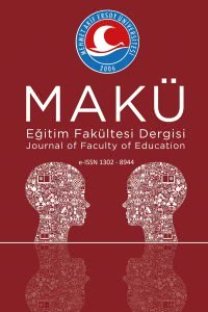8-10 Yaş Grubu Çocukların Somatotiplerinin Belirlenmesi ve Değerlendirilmesi
Araştırma, 8-10 yaş grubu çocukların somatotiplerinin belirlenerek, yaş ve cinsiyete göre değişimlerinin değerlendirilmesi amacıyla yapılmıştır. Araştırmaya ilköğretim okullarında okuyan 8 yaşında 454 (231 erkek, 223 kız), 9 yaşında 412 (216 erkek, 196 kız), 10 yaşında 403 (224 erkek, 179 kız) olmak üzere toplam 1269,sağlıklı öğrenci gönüllü katıldı. Veriler, deneklerin boy uzunluğu vücut ağırlığı, slinfold ölçümleri, çap ve çevre ölçümleri , kullanılarak toplandı ve Heath-Carter somatotip derecelendirme metodu ile değerlendirildi. Tüm deneklerin ölçüm ve hesaplanan değişkenlere yönelik,standart sapmaları alındı; gruplar arasındaki farklılıkların tespitinde One-Way ANOVA/Tukey ve Independent Samples t testi analizleri kullanıldı. Araştırmaya katılan çocukların somatotip ortalamaları; 8 yaş grubu erkek çocuklarda 3,0-4,6-2,6, kız çocuklarda 3,5-4,3-2,5; 9 yaş grubu erkek çocuklarda 3,0-4,6-2,7, kız çocuklarda 3,5-4,l-2,7; 10 yaş grubu erkek çocuklarda 3,2-4,4-2,9, kız çbcuklarda 3,8-4,2-2,8 olarak belirlendi. Erkek ve kız gruplarda, yaşlar arasında endomorfi, mezomorfi ve ektomorfi puanlarında anlamlı fark bulunmadı (P>0,05). Fakat cinsiyetler arasında endomorfide tüm yaşlarda, mezomorfide sadece 8 ve 9 yaş grubunda faklılık tespit edildi (P0,05). Sonuçta, 8-10 yaş grubu erkek ve kız çocuklarda, somatotipi oluşturan bileşenlerden endomorfi ve mezomorfi değerlerinin yaşa bağlı değişmediği, ancak aynı yaş gruplarında cinsiyete göre değiştiği, kızların endomorfi, erkeklerin mezomorfi değerlerinin daha yüksek olduğu, ektomorfinin ise her iki cinsiyette de yaşa bağlı olarak artığı, fakat tüm yaş gruplarında cinsiyete bağlı faklılık olmadığı ifade edilebilir.
The Identification and Evaluation of Somatotypes of 8-10 Years Old Children
The present study is aimed to identify the somatotypes of 8-10 years old children and to evaluate the changes relative to age and gender of the subjects. The subjects were 1269 healthy, elementary school students who were grouped as 454 (231 boys and 223 girls) children at the age of 8; 412 (216 boys 196 girls) children at the age of 9; and 403 (224 boys and 179 girls) children at the age of 10. The data were collected by measuring the height, weight, skinfold values, diameter circumference and they were evaluated with Heath-Carter Somatotype Ranking Method. The mean and standard deviations of measurement and calculated variables of all the subjects were taken; the analyses of One-Way ANOVA/Tukey and Independent Samples t Tests were used to calculate the differences between the groups. The somatoypes of the children who participated in the study were found as follows: 3,0-4,6-2,6 in 8-year-old boys; 3,5-4,3-2,5 in 8-year-old girls; 3,0-4,6-2,7 in 9 year-old boys; 3,5-4,1-2,7 in 9-year-old girls; 3,2-4,4-2,9 in 10-year-old boys; 3,8-4,2-2,8 in 10-year-old girls. The differences in the values of endomorphy, mezomorphy and ektomorphy relative to age groups were found to be insignificant (P>0,05). However there were significant differences in endomorphy relative to gender among all age groups and in mezomorphy only between the age groups of 8 and 9 (P<0.01). No gender differences found in ektomorphy (P>0,05). As a result, it can be asserted that the values of endomorphy and mezomorphy, the components which constitute the somatotype, do not change relative to age in children from 8 to 10; yet, that those values show changes in the same age groups relative to gender; that the values of endomorphy in girls and mezomorphy in boys are higher; that the values of ektomorphy show increase relative to age in both sexes; and finally, that there are no differences in all ages relative to gender.
___
Birer, R.B., Levine, R., (1987) Performance Parameters in Children and Adolescent Athletes, Sports Medicine, 4:211-227.Carter, J.E.L... Heath, B.H., (1990) Somatotypeing-Development and Applications, Camridge University Press, Cambridge, 130-181.
Gürses Ç., Olgun P., (1984) Sportif Yetenek Araştırma Metodu (Türkiye Uygulaması), Türk Spor Vakfı.
Hızal N., (1989) Genç Türk Erişkinlerde Temel Antropometrik Ölçümler ye Yağlanma Oranları, Yayınlanmamış Yüksek Lisans Tezi, istanbul: İÜ Çocuk Sağlığı Enstitüsü.
Malina, R.M., Bouchard C., (1991) Growth, Maturation, and Physical Activity, Human Kinetics Publishers Inc, Illinoiss.
Özer K., (1992) Yetenek Seçiminde Yapısal Faktörler, Spor Bilimleri 2. Ulusal Kongre Bildirileri, Ankara: H Ü Spor Bilimleri ve Teknoloji Yüksek Okulu, Yayını No: 3, 301-313.
Özer K, (1993) Antropometri Sporda Morfolojik Planlama, İstanbul: Kazancı Matbaacılık.
Öztürk, F., Yücel, B., Temoçin, S., Kuter, M., ve Olaru, A.M., (?). Spor Bilimleri Sözlüğü. Türk Spor Vakfı Yayını, s: 62.
Ross, W.D., Ward R., (1984) Proportionality of Olympic Athletes, Medicine Sport Sci., vol 18 pp 110, Basel.
Tamer K., (2000) Sporda Fiziksel-Fizyolojik Performansın Ölçülmesi ve Değerlendirilmesi, Ankara: Bağırgan Yayımevi.
Turnagöl, H.H. ve Demirel, H., (1992). Türk Milli Haltercilerinin Somatotip Profilleri ve Bazı Antropometrik Özelliklerinin Performansla ilişkisi.HÜ Spor Bilimleri Dergisi, 3 (3), 11 -18.
- ISSN: 1302-8944.
- Yayın Aralığı: Yılda 2 Sayı
- Başlangıç: 2018
Sayıdaki Diğer Makaleler
Bucak ve Çeltikçi İlçelerinde Tütün Tarımı
Dursun GÜLER, ŞÜKRÜ SERDAR BALCI, FİLİZ FATMA ÇOLAKOĞLU, Selma KARACAN
Antalya'nın Kuzeybatısında Kalan Sahanın Bitki Örtüsü
Saldırganlık Ölçeği Geçerlik Güvenirlik Çalışması
Sınıf Öğretmenlerinin Mesleki Gelişimleri ile İlgili Görüşleri
Kürşad YILMAZ, Cenk YOLDAŞ, M. Kürşad YANGİL
Burdur Eğitim Fakültesinde Eğitim Gören Öğretmen Adaylarının Profili
Yaşantısal Öğrenme Kuramının Coğrafya Öğretimine Uygulanması
